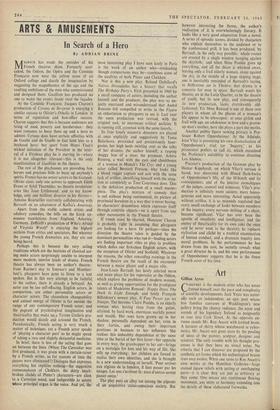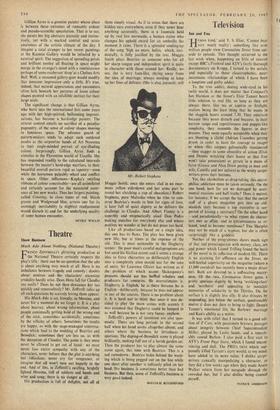Art
Gillian Ayres
cc"lAREFREE is the modern artist who has never fretted himself over the pace and complexity of scientific developments. Jack Yeats was natur- ally such an independent, an epic poet whose less familiar canvases at Waddington's new gallery bring the chancy radiance, the scent and sounds of his legendary Ireland as poignantly as ever into Cork Street. At the opposite ex- treme stands Mr. Roy Ascott with knitted brow. A lecturer of thirty whose watchword is cyber- netics, Mr. Ascott sets great store by the pooling of ideas of the painter, sculptor, designer and scientist. The only trouble with his thought pro- cesses is that they have no visual value. No criteria that I can discover are proposed by the synthetic art forms which his technological brains trust may evolve. When one turns to Roy Ascott's own works at the Hamilton Galleries—large stained jigsaw reliefs with jutting or overlapping parts—it is clear they are just as arbitrary as they come. One misses any continuous flowing movement,,any unity or harmony extending into the details of these elaborated fretworks.
Gillian Ayres is a genuine painter whose place is between these extremes of romantic ardour and pseudo-scientific speculation. That is to say, she paints her big abstracts joyously and instinc- tively, yet with a marked control and acute awareness of the artistic climate of the day. I imagine a total stranger to her recent paintings at the Kasmin Gallery would be infected by a carnival spirit. The suggestion of spreading petals and brilliant motley all floating in space might merge in the stranger's mind with a reminiscence perhaps of some exuberant 'drop' at a Chelsea Arts Ball. Well, a seasoned gallery-goer would modify that innocent impression only a little. It's true, indeed, that natural appearances and encounters often lurk beneath her patterns of loose colour shapes painted with an infallible instinct for their large scale.
The significant change is that Gillian Ayres, who burst into the international lists some years ago with her high-spirited, ballooning improvi- sations, has become a hard-edge painter. The stricter control entails no sacrifice of a peculiar pageantry, of the sense of colour shapes moving in luminous space. The advance guard of pattern-makers tends to adapt such outdated modes as the serpentine bands of Art Nouveau to their single-minded pursuit of eye-illuding colour. Surprisingly, Gillian Ayres finds a stimulus in the Florentine world of Uccello. She has responded readily to the calculated intervals between the master's hard-edge warriors, to their beautiful overall pattern rigid as tapestry–even while the horsemen palpably wheel and conflict in space. Other influences—Kupka's swirling ribbons of colour conceivably—are all assimilated and certainly 'account for the measured assur- ance of her new works. Thus her largest painting, called Greeting, in close tones of red, bluish greens and Wedgwood blue, arrests one for its seemingly inevitability (a slightest readjustment would disturb it) and for the underlying quality of some human encounter.
NEVILE WALLIS



































 Previous page
Previous page